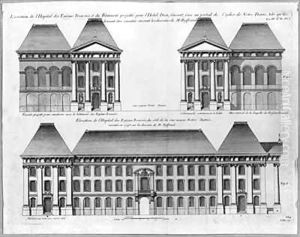Germain Boffrand Paintings
Germain Boffrand was a prominent French architect who played a significant role in the development of the Rococo style, which is characterized by its elaborate ornamentation, organic forms, and lightness. Boffrand was born on May 16, 1667, in Nantes, France. He was trained by the architect François Mansart, one of the key figures in French Baroque architecture. Under Mansart's guidance, Boffrand developed his skills and began to establish his own approach to architectural design.
In 1685, Boffrand moved to Paris, where he continued his training and eventually became a member of the Royal Academy of Architecture. His early work was in the Baroque style, but as his career progressed, he began to introduce more playful and decorative elements into his designs, which was a shift towards the Rococo.
Boffrand's career spanned over 60 years, during which he designed numerous private residences, including the Hôtel de Soubise in Paris, which is considered one of his masterpieces. The Hôtel de Soubise showcased Boffrand's skill in integrating Rococo aesthetics with classical structure, marking a seamless blend of opulence and elegance. Boffrand's work was not limited to private commissions; he also contributed to public projects and religious buildings. His versatility allowed him to adapt to various types of commissions and client demands.
One of Boffrand's significant contributions to architecture was his theoretical work. He published a book titled 'Livre d'architecture' in 1745, which included a variety of designs for city planning, gardens, and buildings, and reflected his architectural principles. This work emphasized the importance of harmony between architecture and its natural surroundings, a concept that was ahead of its time.
Germain Boffrand died on March 19, 1754, in Paris. His legacy continued to influence French architecture, and his works remain celebrated examples of the Rococo style. Boffrand's designs and theoretical contributions have had a lasting impact on the field of architecture, bridging the gap between the grandeur of the Baroque and the whimsical charm of the Rococo.
